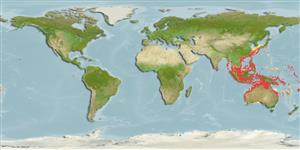Environment: milieu / climate zone / depth range / distribution range
पारिस्थितिकी
समुद्री प्रवाल-भित्ति संयुक्त; गहराई सीमा 10 - 133 m (Ref. 9710), usually 10 - 58 m (Ref. 90102). Tropical
Western Pacific: Andaman Sea to the Solomon Islands, north to southern Japan, south to northwestern Australia and the Great Barrier Reef (Ref. 2334).
आकार / वज़न / Age
Maturity: Lm ? range ? - ? cm
Max length : 12.0 cm TL पुल्लिंग / अलिंग; (Ref. 48635)
पृष्ठीय रीढ़ (सम्पूर्ण): 10; पृष्ठीय सौफट रेज़ (सम्पूर्ण): 16; गुदा कांटा 3; ऐनल सौफट रेज़: 7. Juveniles recognized by lavender tipped dorsal spines (Ref. 48635). Similar to P. connelli in South Africa (Ref. 37816).
Found in aggregations around isolated coral heads and rubble patches (Ref. 9710). Juveniles enter harbors and often on silty rocky reefs (Ref. 48635).
Life cycle and mating behavior
परिपक्व अवधि | पुनरुत्पत्ति | मछलीऔ का अंडे देना | अंडे | Fecundity | लार्वा
Randall, J.E., G.R. Allen and R.C. Steene, 1990. Fishes of the Great Barrier Reef and Coral Sea. University of Hawaii Press, Honolulu, Hawaii. 506 p. (Ref. 2334)
IUCN Red List Status (Ref. 130435)
Threat to humans
Harmless
Human uses
अधिक जानकारी
आम नामउपशब्दचपायचयपरभक्षीईकोटोकसीकोलौजीपुनरुत्पत्तिपरिपक्व अवधिमछलीऔ का अंडे देनाSpawning aggregationFecundityअंडेEgg development
संदर्भजलीयकृषिजलीयकृषि रूपरेखाखींचआनुवंशिकीElectrophoresesहैरेटिबिलटीबीमारीप्रक्रमणNutrientsMass conversion
सहयोगीयोतस्वीरेStamps, Coins Misc.ध्वनिसिगुयटिरारफ्तारतैरने के प्रकारगिल क्षेत्रOtolithsदिमागदृष्टि
साधन
Special reports
Download XML
इंटरनेट स्रोत
Estimates based on models
Preferred temperature (Ref.
123201): 24.2 - 28.9, mean 27.6 °C (based on 834 cells).
Phylogenetic diversity index (Ref.
82804): PD
50 = 0.5000 [Uniqueness, from 0.5 = low to 2.0 = high].
Trophic level (Ref.
69278): 3.4 ±0.45 se; based on food items.
लौटाव (Ref.
120179): ऊंचा, न्यूनतम जनसंख्या दुगनी समय अवलागत 15 महीने। (Preliminary K or Fecundity.).
Fishing Vulnerability (Ref.
59153): Low vulnerability (10 of 100).
Nutrients (Ref.
124155): Calcium = 96.4 [52.5, 187.3] mg/100g; Iron = 0.874 [0.472, 1.529] mg/100g; Protein = 18 [16, 20] %; Omega3 = 0.19 [0.11, 0.31] g/100g; Selenium = 32.2 [17.6, 63.7] μg/100g; VitaminA = 201 [69, 659] μg/100g; Zinc = 1.57 [1.04, 2.26] mg/100g (wet weight);
